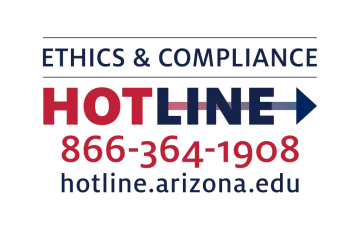Compliance

Compliance is integral to the programs and services of the University of Arizona.
Every member of the university community has a responsibility, to themselves and each other, to uphold expectations provided in law, and our policies, codes, and standards. Compliance means acting to adhere to expectations and requirements of applicable laws, regulations, policies, and standards of conduct. The University of Arizona is a vibrant and complex institution with a diverse range of activities and community members. In our complex environment, achieving compliance can be challenging, however by consistently applying our compliance tools and practices, we can successfully navigate these challenges.
The foundations of the university’s compliance plan are rooted in standards established in the Federal Sentencing Guidelines §8B2.1 Effective Compliance and Ethics Program.
1. Effective Compliance Oversight
- The Arizona Board of Regents, the President, the Chief Compliance Officer, the University Compliance Office, and Compliance Partners hold important roles in oversight and accountability for compliance obligations.
2. Compliance System Design
- University policies, institutional and unit-level compliance programs, and written standards and procedures, establish a documented system that consistently shapes compliance-related behavioral expectations and procedural duties and tasks.
3. Education and Training
- Compliance training and education provide awareness, transmit and reinforce knowledge of compliance requirements, and serve as foundations for compliance conversations to strengthen programs and identify gaps and needs.
4. Periodic Risk Identification
- Routine proactive compliance risk assessments and reviews provide an objective assurance that compliance obligations are well-managed.
5. Report Assessment, Investigation, and Response
- Development of a culture of reporting compliance and ethical concerns, ensuring appropriate response and action to reports, and documentation through issue tracking and trend analysis are key tools used throughout the university.
6. Monitoring, Auditing, and Evaluation
- A framework of subject-matter experts develop and promote transparent and effective mechanisms to analyze current and developing regulations, regulatory reporting obligations and deadlines, and compliance-related needs and focus areas.
7. Continuous Improvement
- Development of gap closure action plans, continuous improvement goals, and routine evaluation and updates to policies and procedures ensure progressive correction and improvement.
The following compliance tools and guides support consistent adherence to best practices and requirements and promote ethical decision-making and actions.
Higher Education Compliance Alliance (HECA) provides the higher education industry with extensive information and resources for compliance with federal laws and regulations, including a comprehensive Compliance Matrix.
Society for Corporate Compliance and Ethics (SCCE) is an organization that supports higher education compliance and ethics. The SCCE offers trainings, conferences, publications, and professional networking.
Federal Sentencing Guidelines (2023) establish the seven elements of an effective compliance and ethics program used widely across most corporations and industries.
US Department of Justice (DOJ) Evaluation of Effective Compliance Programs (September 2024) is the Federal framework used in evaluation of the adequacy and effectiveness of compliance programs.

